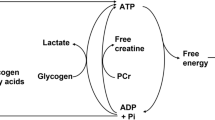Abstract
Thoroughbred horses were exercised to fatigue on a treadmill at 62% and 100% of their VO2max. Hypoxemia occurred at the onset of exercise under both exercise conditions. This hypoxemia persisted to fatigue during the heavy exercise but progressively diminished as the exercise continued and had disappeared by the end of exercise at the lighter load. As a result of the hypoxemia the oxygen content of arterial blood during exercise at VO2max was 17% below its carrying capacity. However, under both experimental conditions the CaO2 still exceeded that of rest owing to an elevation in hemoglobin concentration. The temperature of blood at the point of fatigue was similar, 41.0±0.2 ° C and 41.1±0.2 ° C, for exercise at 62% and 100% VO2max, respectively. Muscle samples collected at rest and at the termination of exercise did not demonstrate major differences between the exercise conditions except for a higher [lactate] and lower pH following the heavy exercise. From these results it can be suggested that the combined effects of an elevated body temperature, changes in muscle pH, and oxygen delivery may all be factors contributing to limit exercise capacity in the horse.
Similar content being viewed by others
References
Baker MA (1982) Brain cooling in endotherms in heat and exercise. Annu Rev Physiol 44: 85–96
Bayly WM, Grant BD, Kramer JW, Breeze RG (1983) The effects of maximal exercise on acid-base balance and arterial blood gas tension in thoroughbred horses. In: Snow DH, Persson SGB, Rose RJ (eds) Equine exercise physiology. Granta, Cambridge, pp 400–407
Bayly WM, Schulz DA, Hodgson DR, Gollnick PD (1987a) Ventilatory responses to exercise in horses with exercise-induced hypoxemia. In: Gillespie JR, Robinson NE (eds) Equine exercise physiology: II. Edwards Brothers, Ann Arbor, Mich., pp 172–182
Bayly WM, Schulz DA, Hodgson DR, Gollnick PD (1987b) Ventilatory responses of the horse to exercise: effect of gas collection systems. J Appl Physiol 63: 1210–1217
Bayly WM, Hogdson DR, Schulz DA, Dempsey JA, Gollnick PD (1989) Exercise-induced hypercapnia in the horse. J Appl Physiol 67: 1958–1966
Bergstrom J (1962) Muscle electrolytes in man. Scand J Clin Lab Invest 68: 11–100
Bramble DM, Carrier DR (1983) Running and breathing in mammals. Science 219: 251–256
Caputa M, Feiskorn G, Jessen C (1986) Effects of brain and trunk temperature on exercise performance in goats. Pflügers Arch 406: 184–189
Dempsey JA, Hanson PG, Henderson KS (1984) Exercise induced arterial hypoxaemia in healthy human subjects at sea level. J Physiol (Lond) 355: 161–175
Harrop GA (1919) The oxygen and carbon dioxide content of arterial and of venous blood in normal individuals and in patients with anemia and heart disease. J Exp Med 30: 241–257
Hastings AB, White FC, Sanders TM, Bloor CM (1982) Comparative physiological responses to exercise stress. J Appl Physiol 52: 1077–1083
Jessen C (1987a) Thermoregulatory mechanisms in severe heat stress and exercise. In: Hales JRS, Richards DAB (eds) Heat stress: physical exertion and environment. Elsevier Science, Amsterdam, pp 1–18
Jessen C (1987b) Hyperthermia and its effect on exercise performance. In: Hales JRS, Richards DAB (eds) Heat stress: physical exertion and environment. Elsevier Science, Amsterdam, pp 241–249
Jones JH, Taylor CR, Lindholm A, Straub R, Longworth KE, Karas RH (1989) Blood gas measurements during exercise: errors due to temperature correction. J Appl Physiol 67: 879–884
Kelso TB, Hodgson DR, Visscher AR, Gollnick PD (1987) Some properties of different skeletal muscle fibers: comparison of reference bases. J Appl Physiol 62: 1436–1441
Landgren GL, Gillespie JR, Fedde MR, Jones BW, Pieschl RL, Wagner PD (1988) VO2 transport in the horse during rest and exercise. In: Gonzalez NC, Fedde MR (eds) Oxygen transfer from atmosphere to tissues. Plenum, New York, pp 333–336
MacDougall JD, Reddan WG, Layton CR, Dempsey JA (1974) Effects of metabolic hyperthermia on performance during heavy prolonged exercise. J Appl Physiol 36: 538–544
Nielsen M (1938) Die Regulation der Körpertemperatur bei Muskelarbeit. Skand Arch Physiol 79: 193–230
Pan LG, Forster HV, Kaminski RP (1986) Arterial vs. rectal temperature in ponies: rest, exercise, CO2 inhalation, and thermal stresses. J Appl Physiol 61: 1577–1581
Pelletier N, Blais D, Vrins A, Robinson NE (1987) Effect of submaximal exercise and training on dead space ventilation in the horse. In: Gillespie JR, Robinson NE (eds) Equine exercise physiology: II. Edwards Brothers, Ann Arbor, Mich., pp 225–234
Rose RJ, Hodgson DR, Kelso TB, McCutcheon LJ, Reid T-A, Bayly WM, Gollnick PD (1988) Maximum O2 uptake, O2 debt and deficit and muscle metabolites in thoroughbred horses. J Appl Physiol 64: 781–788
Rowell LB, Taylor HL, Wang Y, Carlson WS (1984) Saturation of arterial blood with oxygen during maximal exercise. J Appl Physiol 19: 282–286
Saltin B, Gollnick PD (1983) Skeletal muscle adaptability: significance for metabolism and performance. In: Handbook of Physiology. Skeletal muscle, Am Physiol Soc, Bethesda, Md., section 10, chapter 19. pp 555–563
Sexton WL, Erickson HH, DeBowes RM, Sigler DH (1985) The effects of training on regulation of blood temperature during exercise in the equine species. Proc Am Assoc Equine Pract. pp 199–208
Author information
Authors and Affiliations
Rights and permissions
About this article
Cite this article
Hodgson, D.R., Rose, R.J., Kelso, T.B. et al. Respiratory and metabolic responses in the horse during moderate and heavy exercise. Pflugers Arch. 417, 73–78 (1990). https://doi.org/10.1007/BF00370771
Received:
Revised:
Accepted:
Issue Date:
DOI: https://doi.org/10.1007/BF00370771




